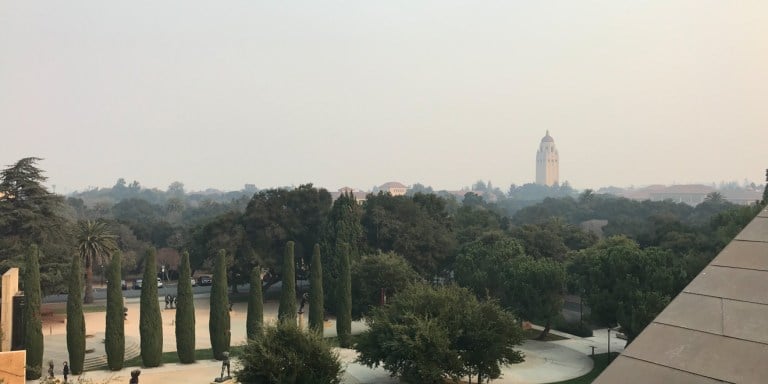Smoke from rampant North Bay wildfires enveloped Stanford campus and the surrounding Bay Area Wednesday, prompting the University to release an AlertSU Community Alert warning of the substandard air quality. Particle pollution reached “unhealthy” levels, the University said.
The raging fires have caused extensive destruction around Napa, Sonoma and Yuba counties. ABC reported Wednesday that at least 23 people had died in the blazes and hundreds had gone missing.
Meanwhile, the Bay Area Air Quality Management District issued a health advisory for the Bay Area in response to the smoke, and warned that the air quality in the following few days will be variable and unpredictable. In Redwood City, the location of the nearest air monitoring station to Stanford, air quality readings were between 151 and 200, notably higher than the standard of 100 and the “orange zone” of 100 to 150, when sensitive groups are advised to stay indoors.
“It’s a really significant health concern,” said Lynn Hildemann, a professor of civil and environmental engineering at Stanford who studies human exposure to particulate matter pollution. “I sent out an email to my department, not as chair but as someone who studies air quality. Skip your workout, use your inhaler if you have one, stay indoors if you can.”
Stanford’s Tuesday Community Alert recommended that those with sensitive respiratory systems should avoid “prolonged or heavy exertion” and seek to stay indoors, while others should reduce exertion and take breaks.
Clara Spars ’21, who hails from Santa Rosa in Sonoma County, said her mother, father and younger brother were woken up at 4 a.m. in the morning on Tuesday by police instructing them to pack their bags and evacuate to Marin County.
“I’m doing well,” Spars said. “My house is still standing and my family is safe.”
“People keep evacuating and then going back when they hear it’s safe, and then evacuating again because the winds pick up,” she added. “It’s so unpredictable and confusing. No one actually knows what’s going on … It was weird walking around and carrying on with my usual routine, knowing that this is going on, and not having a lot of other people know about it.”
At Stanford, Spars noticed that the clear presence of smoke led more people on campus to discuss the fire Wednesday than the day before.
“A professor asked about how my town was doing, and that was nice,” she said. “I think people are catching on.”
Hildemann explained that the Bay Area was the victim of “wind directs.”
“When the wind blows north-to-south, that means it’s bringing it here from Napa. And today, the wind decided to blow north-to-south,” she said.
She noted that large cities in China and India routinely see such poor air quality, saying that “we are normally spoiled around here.”
The smoke has affected several aspects of student life on campus. Javelin thrower Liam Christensen ’21 said the poor air quality affected the track and field team’s practice plans. A 3 p.m. practice on the field was moved inside when an athletic director told the coach that the Air Quality Index reading was 216, or “very unhealthy,” Christensen said.
“We were practicing on Cobb Track and Angell Field and we had to move to the weightlifting area right under the bleachers,” Christensen said. “So we weren’t able to do our planned workout, but we adapted.”
He said some teammates complained of sore throats but added that colds could have been the cause.
The football team experienced a similar hindrance to its practice routine. Football player Colby Parkinson ’21 said the team moved its practice to 7:30 p.m. Wednesday because the air was too polluted earlier in the day.
According to Hildemann, it’s hard to predict what the wind will be like tomorrow. The biggest factor, of course, is whether or not the fire is under control. Her prediction? The smoke is likely to be around campus for a few days.
Contact Alex Tsai at aotsai ‘at’ stanford.edu.
